
Bandar Khyran
A Travel Report in Oman

Bandar Khyran
Oman was an unfamiliar country for me with
very poor imagination of sandy desert and
strong Islamic religion which are shared
with other Arabian countries. Although I
tried to obtain more information on Oman
before my trip was done, my effort was not
fruitful much with very limited information
of the country.
Oman is a very old country, which once colonised
Zanzibar, Tanzania, though its evidence is
hardly in the modern Oman.
January 19 (Narita - Bangkok - (Karachi)
- Muscat
Narita was terribly busy even more than usual.
Hundreds of people were lining up at the
immigration. I always wonder why none of
the Japanese complains about the poor arrangement.
Our flight was delayed to depart because
of late arrival of some passengers. Around
17 hrs, our flight arrived at Bangkok. The
airport is probably one of the most complicated
airport in Asia which requests for going
up and down stairs for transit.
The flight from Bangkok was delayed again.
My impression to the Thai Airways is so now
quite bad. Since the flight is via Karachi,
most of the passengers are Pakistani. They
follow only their own way as they keep standing
for talking with their friends, ask a cabin
clue for changing their seats, drink too
much and vomit immediately, etc. I do not
want see the world where many Indian/Pakistani
travel around after their countries become
rich enough to do so….
After leaving Karachi, more than half seats
became vacant. A large group of Indonesian
ladies were siting back while some Chinese
businessmen were sleeping nearby. Indonesians
must visit the country for working.
The airport in Muscat was fairly large, though
there were only very few airplanes. Mr. I,
a study team member was waiting for me. He
took me to the Ramda Hotel where I stay in
the night. Along the major road near the
hotel, McDonald's was found with the big
red and yellow signboard. Well, it is certainly
all over the world.
January 20 Muscat - Sinaw - Al
Hiji - Film
5:30 a.m., I woke up. My body is still
not fit into the timetable in Oman. After
having breakfast, I visited a counterpart
ministry, a counterpart organisation on our
project. The government officials wear only
typical Arabian clothes, as the sultan in
Oman encourages to do so. For entering the
building, the staff needs to put their hands
on the recorder for the security. The brand
new system is only very recently introduced
into Japan, in the high graded condominiums.

After greeting in the ministry, we start
heading toward Film in Wusta. The road in
Oman is sealed well. Traffic is normally
very fast. Some of the cars are driven by
over 150km/h. After going out from the Muscat
area, landscape is changed to brown, stony
country with very little vegetation. Although
it seems the rocks were formed very long
time ago and fragile, because of the very
limited precipitation, the dynamic gauge
has been kept.
On the way to Film, a large raptor flew over
the road. At the few hundred meters ahead,
several Lappet-faced Vultures were resting
on the stony hill.
The landscape was changed as flat. Over the
barren ground, a mirage was even seen. Film
is a small fishing village with vast tidal
flat and patchy mangrove vegetation. Shorebirds,
including Redshank, Black-tailed and Bar-tailed
Godwits and Curlew Sandpipers were numerous
while Greater Flamingos were seen far away
near the water line. A male Desert Wheatear
was sitting on the rock and flicking its
tail. The wheatear was commonly seen but
somehow always near the beach.
On the way to go back to Hiji, where we stayed
in the night, we noticed soils were white
as snowing. There was some rain around Hiji.
Salt in the soil came up after the rain.
It is surprising to see that the salinity
here is so high!
Twilight time is always good for birdwatching.
A long-billed Hoppoe Lark crossed the gravel
road while a male Spotted Sandgrouse was
sitting on the sand.
The country town was very quiet in the night
unless donkeys uttered loud noises time to
time.
January 21 Al Hiji - Sur - Ras
Al Hadd - Sur
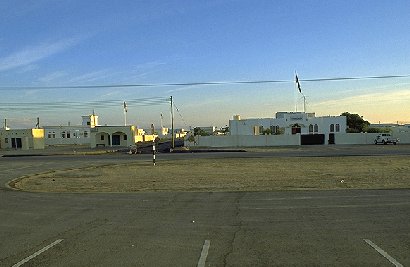
Hiji
A pretty cold morning. Although Oman is
located very close to the Tropic of Cancer,
temperature drops around 10 C in the morning.
Outside was still quiet. Three camels were
lining up for feeding. Accordingly Mr I,
camels go out from and come back to their
cage daily by themselves.
We needed to drove back a few hundred kilometers
as we needed to go to Sur for our monitoring
work. We arrived at Sur about 1:00 p.m..
For our lunch, we went into a local restaurant,
which shows a logo of "Arabian, Chinese
and Indian restaurant", though we ordered
masara curry.
Road from Sur to Ras Al Hadd was gravel and
very rough. In Ras Al Hadd, there is a UAE's
princess villa. The land, which covers huge
area, was leased from the sultan of Oman.
It is unbelievable in Japan.
On the beach in Ras Al Hadd, there were full
of pink shells, which show the beach as pink
beach.
In Sur, we saw a relatively large area of
mangrove forest. An Egyptian Vulture was
sitting on the gorge for overseeing a prey.
Janury 22 Sur - Quriyyatt
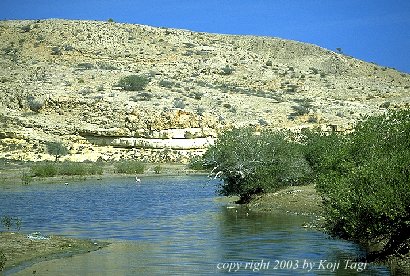
Quriyyatt
Before leaving the hotel, I took a few minutes
walk along the beach. It was productive since
I saw Slender-billed and Sooty Gull on the
beach and Orphean Warbler in the bush near
the hotel.
Sharquiyah region is notorious with the hot
climate in summer. During the summer, the
temperature goes up to 50C.
Coast in Sharquiyah is dynamic and beautiful.
Rocky gauges steeply go down to the turquoise
blue sea.
Accordingly a local tourist guidebook, Mountain
Gazelle is sometimes seen in the area. Unfortunately,
we did not encounter it.
At Quriyyatt, where we did another survey,
I was happy to see a male Citrine Wagtail
while familiar Black-necked Grebes were swimming
in a closed lagoon.
In Oman, goats are quite commonly seen around
and inside of the towns. Local people sometimes
eat goats. Nomadic people in the desert even
eat camels.
In the late afternoon, we came back to Muscat.
After checked into the hotel, I took a walk
around the hotel. Purple Sunbird, Indian
Roller, Indian Silverbill and introduced
Ring-necked Parkeets are common species in
the capital city.
On the beach, many kids are playing football.
The scenery is not much different from a
western country.
January 23 Muscat - Wadi Bani Harras
- Al Ansub Lagoon - Qurm (Muscat)
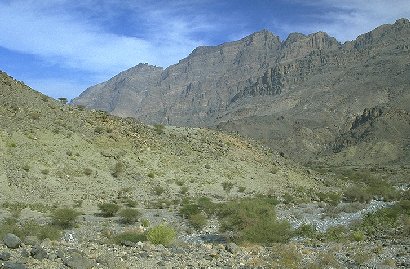
Wadi Bani Harras
In Oman, Thursday and Friday are weekend.
I arranged a rent-a-car and went out for
birdwatching.
At Mutrah, Nicholas Clarke of our studying
team participated in. We firstly headed toward
Wadi Bani Harras. On the way, Little Green
Bee-eaters were often seen on the wire.
After one hour driving, we started birding
after turning from the major road. The first
bird on the gravel road was Isabellline Wheatear.
Unfortunately, it immediately flew away from
us. In a small acacia tree, we found a Desert
Warbler, tiny sandy colour bird.
Along the road, we enjoyed several desert
species. House Bunting was found on the stony
wadi with Desert Larks while Desert Lesser
Whitethroat and Chiffchaff move around in
a small acacia tree. A reddish bird flew
into an acacia tree. It was a handsome male
Black Redstart.
Lichitenstein's Sandgrouse suddenly flew
out from the wadi and disappeared into the
gauge. It was not a good view but impressive
enough.
Highlights were wheatears. Hume's Wheatear
was found on the power line along rocky gauge.
Red-tailed Wheatear was not so colorful bird.
The sandy brown bird was however certainly
distinctive when it shows the rufous tail.
Although I firstly thought it would be a
female Red-tailed, Hooded Wheatear (female)
was unpredicted bonus for us. The slightly
large wheatear has distinctive long bill
and wing.
At Nakhal, we ate lunch. After the lunch,
we visited Al Ansab Lagoon. Although there
are several raptors including Greater Spotted,
Steppe and Imperial Eagles, we were disappointed
because of very little number of song birds.
Before finishing the day, we briefly dropped
into the Qurm Natural Park. It was doubtlessly
wasting time since the park was full of people.
January 25 Muscat - Al Suwadi - Liwa
- Shinas - Haradi - Muscat

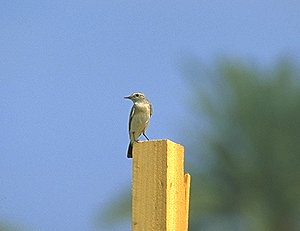
Another day for survey. I left at 8:00 toward
near the boarder with UAE. Batinah region
is mainly developed as farmland. Water is
supplied to the farm (probably, after changed
to fresh water).
Suwadi is planned for development since offshore
in the small town holds good diving spots.
On the sand dune, a flock of Black-crowned
Finch Lark was feeding.
Next stop was at Liwa.
There were large number of gulls and terns,
which include Greater Black-headed, Slender-billed,
Yellow-legged (or Caspian) and Lesser Black-backed
(or Siberian) gulls and hundreds of Lesser
Crested Terns.
We headed up to Shinas for another survey,
then went back approx. 300km to Muscat. Traffic
was busy because of Muscat festival.
January 27 Muscat - Bandar Khyran - Yiti-
Qurm
This is the last day for the field survey.
Since there was rain last night around Muscat,
road condition was relatively bad. On the
way to Bandar Khyran, I saw a Grey Francolin
was sitting on the top of acacia.
Bandar Khyran is a peaceful fishing village.
Local people sometimes visit from Muscat
in the weekend.
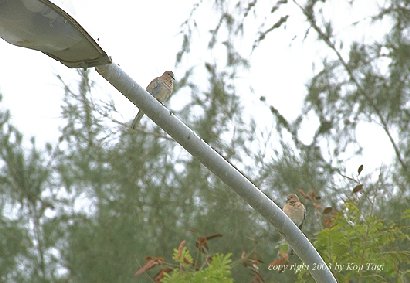
Along the coast, a small flock of Swift (or
Crested) Tern and Slender-billed Gull were
seen.
Qurm is the last destination for the day.
The well-maintained park can be a potential
place for environmental education. Since
Oman takes a significant role on coastal
management in the Middle East region, the
site may be even important regionally.
As I had a mission to visit the Arabian country,
I obtained a good opportunity to do some
birding. Oman is actually a safe and easy
country for tourists. The Omani is friendly
and kind which gives you good impression
to the country. However, travel facilities
are still relatively less developed since
road map is not available with very poor
road signs. Additionally, several good birding
spots are in private property which requires
early permission. It is highly recommendable
early preparation if you have an opportunity
to the wonderful country.